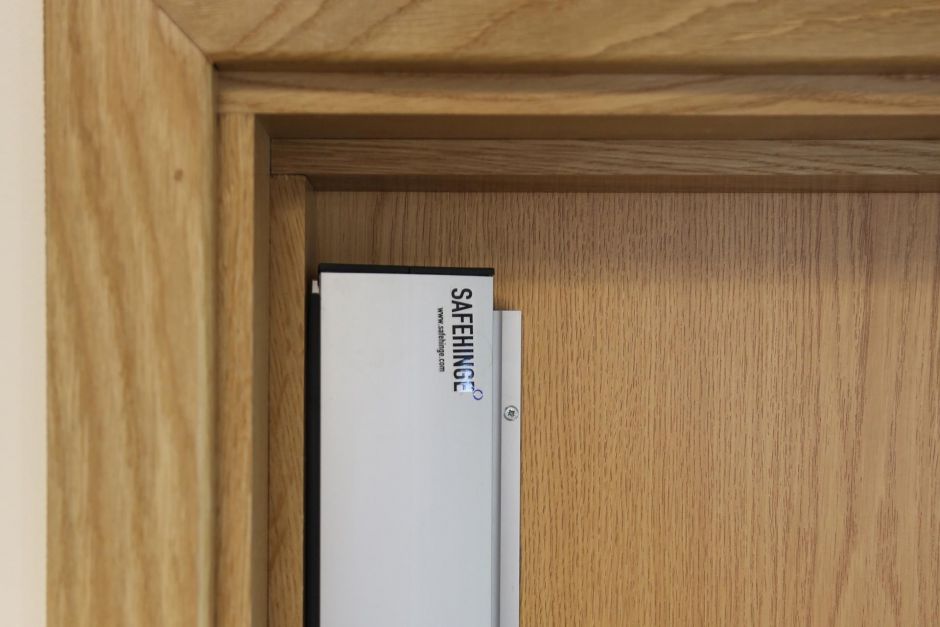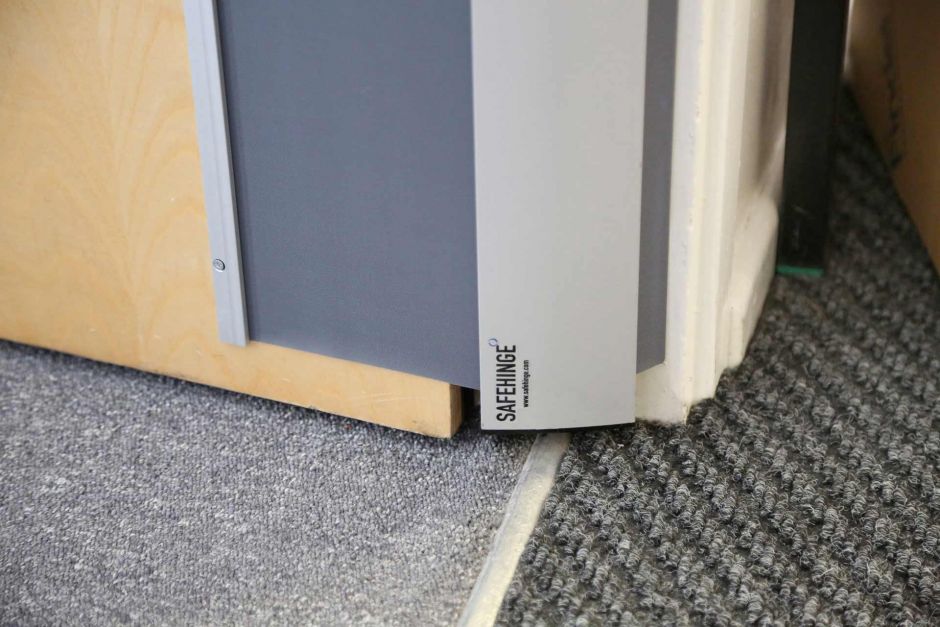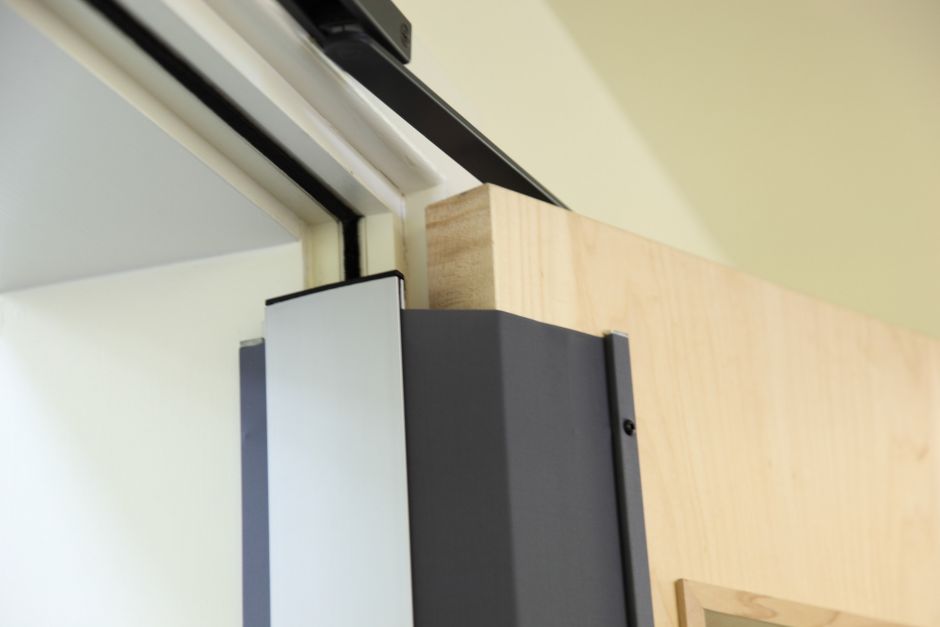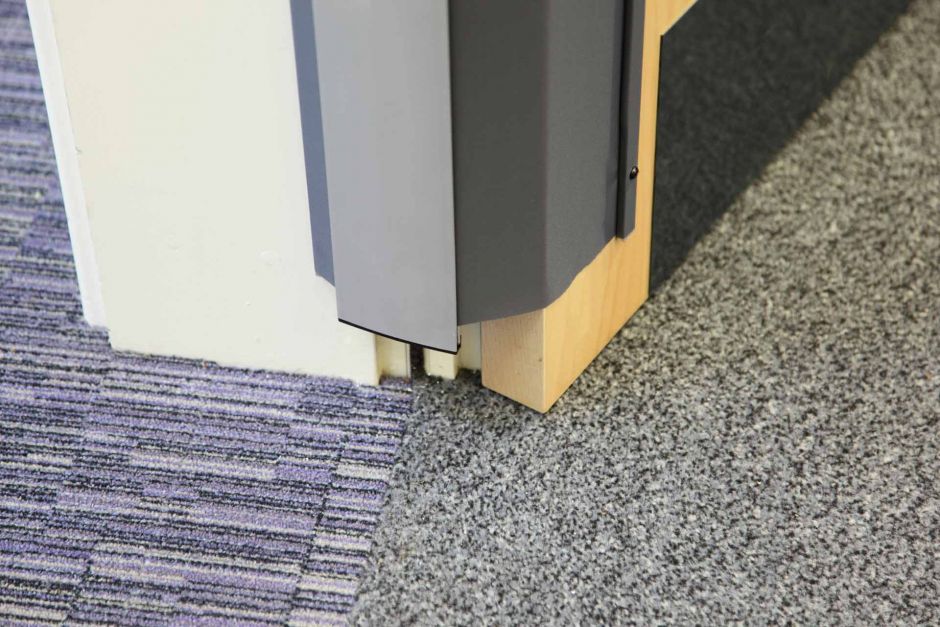Finger Ejecting Guard (Alumini)
Perfect for existing hinged doors.
Alumini is an innovative solution for safe, robust finger protection – designed specifically for existing hinged doors.
This retrofit, surface-mounted finger-ejecting guard offers a 180° opening angle, providing maximum accessibility while actively safeguarding fingers from getting trapped.
Built with durability and efficiency in mind, Alumini combines a semi-circular aluminium body and retracting tear-resistant fabric to create a flexible yet resilient guard that withstands daily knocks, stays easy to clean, and blends seamlessly with door aesthetics.
Product Information
How the ejection system works
The Alumini guard’s clever semi-circular geometry eliminates the need for fabric tension and uses low-force springs to ensure minimal impact on the door’s opening force. The durable aluminium body floats within the door’s hinge gap while retracting fabric sections cover any remaining spaces.
If a finger should stray inside, Alumini’s patented finger-ejection system gently pushes it out, creating an active safety layer for busy environments such as schools, hospitals, and leisure centres.
- Effortless 180° Opening
The Alumini unrestricted opening angle allows the door to reach its full 180°, maximising accessibility and ensuring a clear opening width.
This feature supports Approved Document M compliance by maintaining ease of access without restricting movement. - Quick and Simple Installation
Alumini fits quickly and securely to existing doors, and installation takes only 10 minutes. This retrofit design provides a cost-effective solution for adding reliable finger protection to hinged doors without disrupting day-to-day operations. - Low Maintenance, High Durability
Crafted from tough aluminium, Alumini is resistant to daily wear, bumps, and scrapes.
It maintains its functionality and appearance over time, reducing maintenance costs and keeping doors safe and visually appealing. Unlike plastic and rubber options, the Alumini guard’s smooth, non-porous surface wipes clean easily, supporting high hygiene standards in healthcare and educational settings.


Outperforming Traditional Finger Guards
In high-traffic environments, choosing the proper finger protection is essential.
Here’s how Alumini offers advantages over common alternatives:
Plastic Finger Guards
While inexpensive initially, plastic guards can crack and degrade quickly in busy spaces, becoming a recurring expense due to frequent replacements. Once compromised, these guards lose their protective function, putting users at risk and leading to costly maintenance cycles.
In contrast, Alumini’s aluminium construction lasts the door’s lifetime, saving facilities approximately £500-£1,000 per door over time.
Rubber Finger Guards
Rubber guards are flexible but lack the robust structure needed for high-impact environments. They often collect dust and grime in their folds, requiring regular cleaning. Additionally, their material can stretch and weaken over time, allowing fingers to enter the gap.
Alumini’s design overcomes these issues with a rigid aluminium structure and retracting fabric that doesn’t trap dirt or degrade, ensuring consistent safety and hygiene.
Optimal Applications for Alumini Finger Guards
Alumini is a versatile solution that meets the needs of various high-traffic spaces, providing reliable door finger protection across different sectors.
Education and Childcare Settings
Designed to withstand high impact, Alumini is perfect for schools, nurseries, and leisure centres.
Over 70% of local education authorities trust Shoal’s finger guards, so Alumini ensures pupil safety while providing a durable solution that withstands heavy use.
Healthcare Facilities
Hygiene is essential in hospitals and clinics, and Alumini’s easy-to-clean aluminium surface keeps maintenance simple while meeting high sanitary standards.
Its 180° opening angle also supports accessibility where ease of entry is crucial.
Public and Commercial Spaces
In busy areas like cinemas, restaurants, soft play, and retail spaces, Alumini’s finger-ejecting system protects visitors from potential accidents.
Its quick installation and long-lasting design make it a practical, low-maintenance option for high-traffic public environments.


Alumini-rear
Alumini-rear is our hinge-knuckle guard that protects fingers on the ‘pull’ side of the door. To do this, it fills the small yet dangerous gap created by standard hinged doors, replicating its shape and size for the full length with completely static protection.
If the door opens right back to 180°, e.g. it’s in the middle of a wall, then the hinge knuckle guard is strongly recommended.
Alumini-rear comes in a standard length which is cut to size and fitted in just 10 minutes.
















